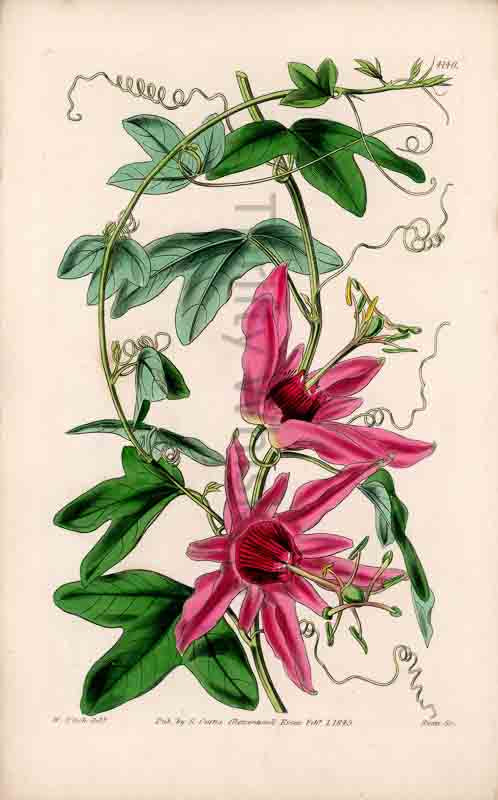Thrifty Whiskers
Plate 4140 Hand-Colored Botanical Print - Digital Download
Plate 4140 Hand-Colored Botanical Print - Digital Download
Couldn't load pickup availability
This is a high-resolution digital download of Plate 4140 from Curtis's Botanical Magazine. The original illustration was hand-colored in the 1800s. This listing includes both the botanical image and its accompanying description tab.
Perfect for art collectors, interior decor, or historical enthusiasts. No physical item will be shipped.
momo e lo ided TAB. 4140
DISÉMMA AURANTIA. New-Caledonia Disemma.
4 sqmia woll sdt mo suborg pauldoorl to zoje odt te moos to con nzielliza slo Jebalo da to smo bilgil arold Nat. Ord. PASSIFLOREE.-MONADELPHIA PENTANDRIA. TO Calyx 10-lobus; tubus brevis subtus sulcatus; faucis corona duplex: exterior filis distinctis; interior filis in membranam integram dentatamve concretis. Ceet. Passiflora.-Species e Nova-Hollandia aut Nova-Cale- donia orta. De Cand. noito hodinu od mo band off as both agit niadt diment oilt to go and DISEMMA aurantia; foliis glabris basi ovatis late trilobatis, lobis obtusis inter medio longiore, lateralibus extus appendice subauctis, bracteis setiformibus apice glandulosis a flore parum remotis, petiolis apice biglandulosis, filis coronæ exterioris lobis cal. internis subæqualibus. De Cand. DISEMMA aurantia. Labill. Sert. Austr. Caled. t. 79. De Cand. Prodr. 3. p. 332. MURUCUJA aurantia. Pers. Syn. 2. p. 222. PASSIFLORA aurantia. Forst. Prodr. p. 326. The Genus Disemma (from 5, double, and σapua, a crown,) was established by Labillardière in his Sertum Austro-Caledo- nicum, upon this very plant, a native of New-Caledonia, and is readily distinguished, on the one hand, from Passiflora by the presence of the membranous, truncated crown of Muru- cuja, and, from the latter, by the outer filamentous crown of Passiflora. The species are all of Australian origin, and include, besides the present, D. Herbertiana, D. coccinea, and D. adiantifolia; the latter from Norfolk Island. The Botanic Gardens of Kew, where our figure was taken in the greenhouse in July, 1844, owe the possession of this hand- some plant to T. Bidwill, Esq. It is easily cultivated in a pot, with wire-trellice, and is remarkable, like D. adiantifolia, for the flowers being nearly white in bud and on first expand- ing, gradually assuming a yellow or tawny tint, and finally becoming a brick red. The sepals have a singularly broad keel or deep wing at the back. Thrifty Whiskers
Botanical Description A twining shrub, with the habit of our common
Passiflora cærulea, everywhere glabrous. Leaves alternate, petiolate, broad, deeply trifid; the segments oblong-ovate, rather obtuse, middle segment the longest, at the base beneath, at the apex of the petiole are two rounded glands. Stipules none, or soon deciduous. Tendrils axillary, simple. Pedun- cles axillary, much shorter than the leaf, bracteated; bracteas small, setaceous, deciduous, distant from the flower. Flowers large, handsome, at first almost white, gradually becoming orange-red, and finally brick-red. Sepals colored, oblong, acute, concave, with a singularly broad carina or wing at the back. Petals scarcely half their length, oblong-obtuse, spread- ing. Outer ray of the corona deep red, consisting of numer- of the ous subulate, erect, or slightly inclined filaments, dark at their tips, united at the base: inner one a conical, red, plicate membrane, open at the mouth, a little longer than the outer ray. Ovary oval, supported, as it were, on the united portion of the filaments, which thus form a cylindrical column, nearly thrice as long as the corona. Styles clavate, spreading. Stigmas capitate. Anthers linear, rather shorter than the free, spreading portion of the filaments, green. 1.2 I omo ied as well gill 10% by bind a
Share



